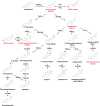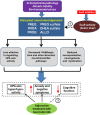Neurosteroids in Schizophrenia: Pathogenic and Therapeutic Implications
- PMID: 29568275
- PMCID: PMC5852066
- DOI: 10.3389/fpsyt.2018.00073
Neurosteroids in Schizophrenia: Pathogenic and Therapeutic Implications
Abstract
Neurosteroids are a group of important endogenous molecules affecting many neural functions in the brain. Increasing evidence suggests a possible role of these neurosteroids in the pathology and symptomatology of schizophrenia (SZ) and other mental disorders. The aim of this review is to summarize the current knowledge about the neural functions of neurosteroids in the brain, and to evaluate the role of the key neurosteroids as candidate modulators in the etiology and therapeutics of SZ. The present paper provides a brief introduction of neurosteroid metabolism and distribution, followed by a discussion of the mechanisms underlying neurosteroid actions in the brain. The content regarding the modulation of the GABAA receptor is elaborated, given the considerable knowledge of its interactions with other neurotransmitter and neuroprotective systems, as well as its ameliorating effects on stress that may play a role in the SZ pathophysiology. In addition, several preclinical and clinical studies suggested a therapeutic benefit of neurosteroids in SZ patients, even though the presence of altered neurosteroid pathways in the circulating blood and/or brain remains debatable. Following treatment of antipsychotic drugs in SZ, therapeutic benefits have also been linked to the regulation of neurosteroid signaling. Specifically, the neurosteroids such as pregnenolone and dehydroepiandrosterone affect a broad spectrum of behavioral functions through their unique molecular characteristics and may represent innovative therapeutic targets for SZ. Future investigations in larger cohorts with long-term follow-ups will be required to ascertain the neuropsychopharmacological role of this yet unexploited class of neurosteroid agents.
Keywords: GABAA receptor; clinical trial as topic; metabolism; neurosteroids; schizophrenia.
Figures




Similar articles
-
Pregnenolone-progesterone-allopregnanolone pathway as a potential therapeutic target in first-episode antipsychotic-naïve patients with schizophrenia.Psychoneuroendocrinology. 2018 Apr;90:43-51. doi: 10.1016/j.psyneuen.2018.02.004. Epub 2018 Feb 7. Psychoneuroendocrinology. 2018. PMID: 29433072 Free PMC article.
-
Pregnenolone as a novel therapeutic candidate in schizophrenia: emerging preclinical and clinical evidence.Neuroscience. 2011 Sep 15;191:78-90. doi: 10.1016/j.neuroscience.2011.06.076. Epub 2011 Jul 1. Neuroscience. 2011. PMID: 21756978 Review.
-
Zuranolone - synthetic neurosteroid in treatment of mental disorders: narrative review.Front Psychiatry. 2023 Dec 5;14:1298359. doi: 10.3389/fpsyt.2023.1298359. eCollection 2023. Front Psychiatry. 2023. PMID: 38116383 Free PMC article. Review.
-
Neurosteroids: A potential target for neuropsychiatric disorders.J Steroid Biochem Mol Biol. 2024 May;239:106485. doi: 10.1016/j.jsbmb.2024.106485. Epub 2024 Feb 17. J Steroid Biochem Mol Biol. 2024. PMID: 38369032 Review.
-
The role of GABA-A and mitochondrial diazepam-binding inhibitor receptors on the effects of neurosteroids on food intake in mice.Psychopharmacology (Berl). 1998 Jun;137(4):391-400. doi: 10.1007/s002130050635. Psychopharmacology (Berl). 1998. PMID: 9676900
Cited by
-
A Potential Mechanism Underlying the Therapeutic Effects of Progesterone and Allopregnanolone on Ketamine-Induced Cognitive Deficits.Front Pharmacol. 2021 Mar 8;12:612083. doi: 10.3389/fphar.2021.612083. eCollection 2021. Front Pharmacol. 2021. PMID: 33767621 Free PMC article.
-
Experiences and Perspectives of GC-MS Application for the Search of Low Molecular Weight Discriminants of Schizophrenia.Molecules. 2022 Dec 31;28(1):324. doi: 10.3390/molecules28010324. Molecules. 2022. PMID: 36615518 Free PMC article. Review.
-
Steroidomics in Men with Schizophrenia.Int J Mol Sci. 2024 Aug 10;25(16):8729. doi: 10.3390/ijms25168729. Int J Mol Sci. 2024. PMID: 39201417 Free PMC article.
-
The association between hormones and antipsychotic use: a focus on postpartum and menopausal women.Ther Adv Psychopharmacol. 2019 Jul 3;9:2045125319859973. doi: 10.1177/2045125319859973. eCollection 2019. Ther Adv Psychopharmacol. 2019. PMID: 31321026 Free PMC article. Review.
-
Neurosteroid influence on affective tone.Neurosci Biobehav Rev. 2023 Sep;152:105327. doi: 10.1016/j.neubiorev.2023.105327. Epub 2023 Jul 25. Neurosci Biobehav Rev. 2023. PMID: 37499891 Free PMC article. Review.
References
Publication types
Grants and funding
LinkOut - more resources
Full Text Sources
Other Literature Sources

